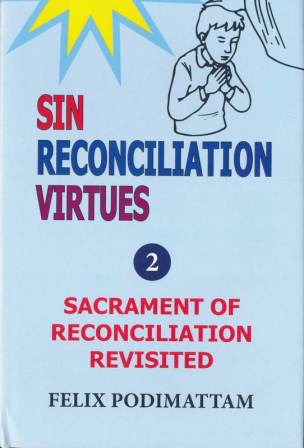Description
Dr. Felix Podimattam is one of the best-known moral theologians in India & outside. Besides his full time job as a professor, he finds time to write books at an amazing rate. He has authored 136 books.Besides his Masters degree in Political Science from Mysore, he holds a Licentiate in Theology from the Pontifical Gregorian University, Rome, & subsequently a Doctorate in Moral Theology from the Alphonsian Academy, Rome. His post-doctoral studies were pursued in Washington, DC, USA. At present he is professor of Moral Theology at St. Francis Theological College, Kottayam, Kerala, India.
CONTENTS
INTRODUCTION
CHAPTER ONE
PRELIMINARY THEOLOGICAL REFLECTIONS
1. A World Thirsting for Reconciliation
2. Church the Sacrament of Reconciliation
3. Penance as the Basic Structure of Christian life
4. Reconciliation in the Bible
4.1. Reconciliation in the OT
4.2. Reconciliation in the NT
5. Teaching of the Official Church on
the Sacrament of Penance
6. The Sacrament of Penance in the Other Churches
7. Three Models of the Sacrament of Penance
8. Penance as Virtue and Penance as Sacrament
9. Sacrament of Penance as Judgment
10. Theological Understanding of Confession
CHAPTER TWO
HISTORY OF THE SACRAMENT OF RECONCILIATION
1. The Patristic Period
2. The Celtic Penitential Movement
3. The Fourth Lateran Council
4. The Council of Trent
5. The New Rite of Penance and Reconciliation
5.1. The Mystery of Reconciliation
5.4. Communal Celebration with Individual Confession
and Individual Absolution
5.5. Communal Rite with General Confession
and General Absolution
5.6. Critical Appraisal of the New Rite
5.7. Reconciliatio et Paenitenti
6. Lessons from History
CHAPTER THREE
THE SACRAMENT OF RECONCILI ATION
IN NEED OF METAMORPHOSIS
1. From an ‘Other-Worldly’ Liturgy to
‘This-Worldly’Liturgy
2. From a “Magical” to Performative Ritual
3. From Globalized Liturgy to ‘Glocalized’ Liturgy
4. Private Penance: Ordinary Form to
Extraordinary Form
5. Learning from Social Reconciliation:
Overcoming Cheap Grace
6. Learning from Social Reconciliation:
Reconciliation is a Process
7. How to Celebrate the Sacrament of
Reconciliation Today
CHAPTER FOUR RESTRUCTURING OF
THE SACRAMENT OF RECONCILIATION
1. Changing Notions of Sin and
the Celebration of the Sacrament of Reconciliation
1.1. The Reality of Sin
1.2. Sin as Alienation
1.3. ‘Sin as Action’ to ‘Sin as Attitude’
1.4. Personal Sins to Social Sins
2. Rediscovery of the Communitarian Dimension
3. Private or Communal to Private and Communal
CHAPTER FIVE
THE CONFESSOR
1. The Role of the Priest-Confessor
1.1. Choice of the Confessor
1.2. The Location of Confession
1.3. A Good Confessor
1.4. The Other Side of the Confessional
2. The Sacramental Task of the Confessor
2.1. The Sacred Atmosphere
2.2. Receiving the Penitent
2.3. Grasping the Penitent’s Dispositions
2.4. Confession
2.5. Contrition
2.6. Sincere Purpose of Amendment
2.7. The Penance
3. The Moral Task of the Confessor
3.1. Correcting the Penitent
3.2. Spiritual Direction in Confession
4. Confession of the Scrupulous Penitent
CHAPTER SIX
DEVOTIONAL CONFESSION
1. The Priestly Ordeal of Hearing
Devotional Confessions
2. The Uselessness of Many of the
Devotional Confessions
3. Eucharist Forgives Sins
4. No Absolute Necessity of Confession of Mortal Sins
CHAPTER SEVEN SACRAMENT OF PENANCE
AND SOCIAL JUSTICE QUESTIONS
1. Positive and Negative Principles Involved in
the Examination of the Social Conscience
3. Role of the Confessor Promoting His Penitent’s Orientation towards Human Development
4. The Sacrament of Penance in
the Service of the Divine Law of Human Development
CONCLUSION
BIBLIOGRAPHY
ENDNOTES





Reviews
There are no reviews yet.